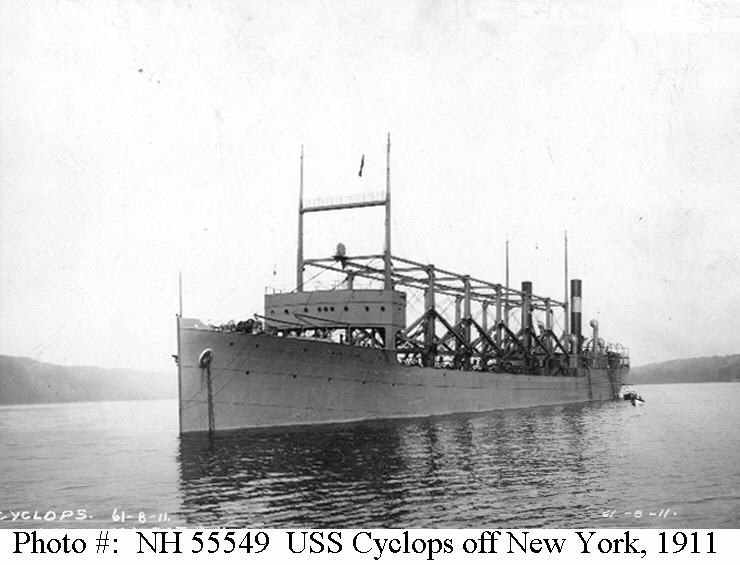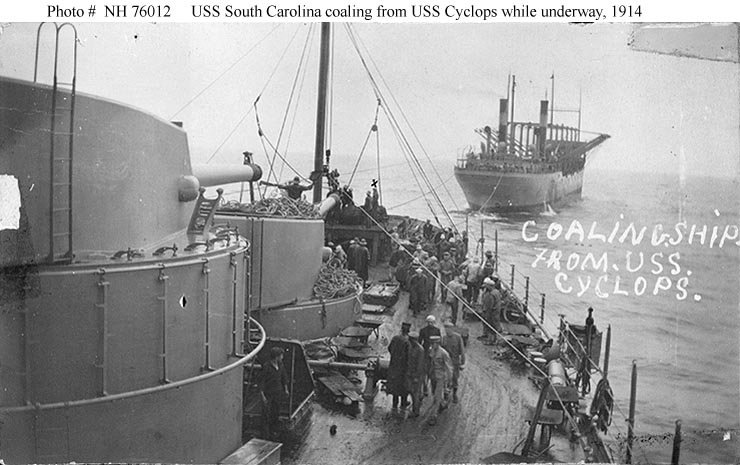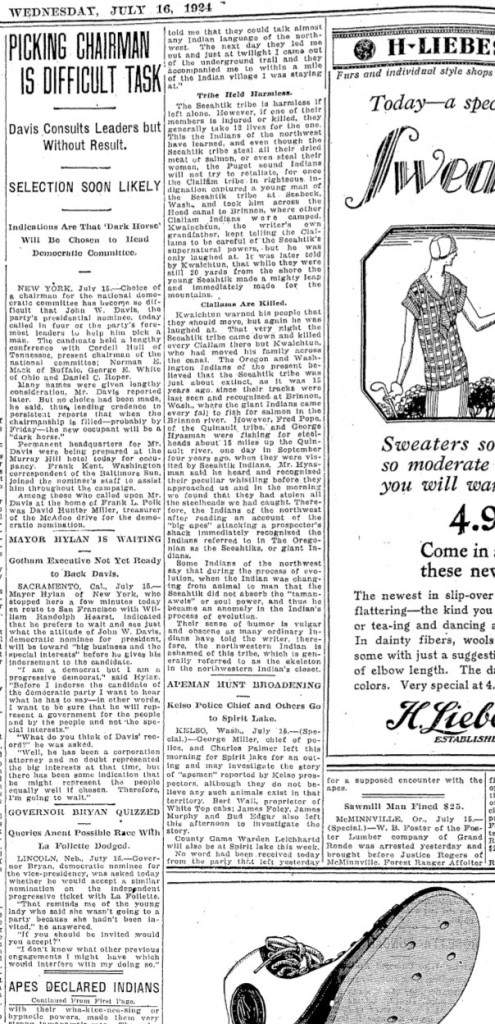Earliest documented Bigfoot Sighting in Pacific Northwest – Part 2
In part one we learned about a tribe of Pacific Northwest Indians called the Seeahtiks. Described as hairy like a bear, seven to eight feet tall, and attributed supernatural powers such as the ability to turn invisible. They have been known to steal Indian women, be vulgar and obscene, play practical jokes, steal meat and fish from other indians, can imitate all of the northwestern birds, and speak most of the languages of the other Indian Tribes in the area.
I was never able to find the original article of the “attack” by Apemen at Spirit Lake, the same lake practically obliterated when Mount St. Helens erupted almost six decades after these events took place. Below is a recap of the original attack and the aftermath after locals went out to look for these mysterious Apemen.
The news of the Ape-men, or Seeahtiks continued to be front page news for the Oregonian the next day. (July 17. 1924)

APE HUNT TO FAIL, INDIAN PREDICT
Seeahtiks Said to Roam at Spirit Lake.
STRANGE EVENTS RELATED
Big-Breasted Giants Take Revenge on Tribesmen.
CEDAR IS LEFT ON DEAD
Shaggy Monsters Reputed to Be Strong Enough to Pull Off Heads of Humans
BY JORG TOTSGI, Clallam Tribe. Editor of the Real American.
HQUIAM, Wash., July 16 – (Special.) – That the apeman hunt now being conducted by Kelso people will meet with failure is the foregone conclusion of Indians of the northwest who know the habits and supernatural powers of these Seeahtik Indians or the lower class of Seeahtiks, which the Clallams call the Tyapish to Nung-Nung, the name given them by the lower Chehalis tribe.
Local Indians assert that the Seeahtik tribesmen generally make their appearance around Mount St. Helens the later part of July and as a general rule do not remain there very long. Then they move north to the the Olympic range, where they do their fall fishing in the upper parts of the Quinault and Brinnon river. Then about the first of November or with the first breath of winter they start their southward journey to Vancouver island, there they remains during the entire winter.
Spirit Lake Weird.
Old Indians of the upper Chehalis, the Cowlitz, and the Quinault asset that Spirt lake is a weird lake. Many strange things have happened there and many weird tales and legends abound in the region of the Spirit lake country. It is said of the old Indians that only the strongest among them sought their Tamanaweis, or sou power, in the lake. There were some who came back and became strong medicine men among their tribe, but more often they were never heard from again.
Allen Chenois, a local Indian, told the following story to the writer regarding the Tyapish Indians:
“My uncle, old man Chenois, told me once that he found a party of other Indians while out hunting some years ago and came upon a band of the Tyapish Indians during their evening meal in Baker’s slough on the Willapa bay. The giant Tyapish seemed to be talking to the others in queer animal sounds, which my uncle could not make out. The Tyapish licked his greasy paws, then wiped them on his naked sides. Crouched around him on their hames were several others.
Tribesmen Deep-Chested.
“In appearance they were much the same. They were tall, narrow hipped and had crooked legs, and at the same time were deep-chested with heavy arms and enormous hands. They were covered with thick hair and had large breasts. Their heads were matted with uncut hair and black glittering eyes like the eyes of birds. Their jaws were massive. At one side of them partly devoured lay the carcass of a deer. It was a clear starlight night and we could make them out very plainly, but they were so ferocious looking my uncle said that we did not stay very long.”
Allen Chenois added that the Tyapish had not killed any Indians of the past generation that he knows of, but he had heard that former Chehalis Indians had been murdered at times by the giant Indians. They were so strong it is known they could pull a grown man’s head right off.
L. Peter James of the Lummi tribe related last year to the writer that the Seeahtik always leaves a tiny branch of cedar tree at places they have visited or upon people whom they have killed or played a practical joke on. The Duwamish tribe at one time related that some of their women had been stolen. The Seeahtiks in a rage killed 12 of the Duwamish tribe by ripping them in two. Mr. James’ mother, who is still alive, was a witness to the tragedy. She said; “They took our young men like toys, turning them upside down and ripping them in two like a piece of calico. Never again did the Duwamish tribe seek revenge when their women and babies were stolen by these Snayihum or Indians of the night and brothers to the Noseless one.”
“It was a custom of their to steal dried calm from the Lummi Indians,” said Mr. James. “The Seeahtiks are tall, hairy creatures and are great travelers.”
Tradition of the Pacific coast Indians bears out the fact they they were animals at one time, and during the process of evolution when they were changing from the animal to man the Seeahtiks did not absorb the Tamanaweis or soul power, and they became and anomaly in the process of evolution.

PENDLETON, Or., July 16 – (Special)- That the so-called “mountain devils” of the Cascades, said to have been seen near Spirit lake may be the descendants of a low type Indian that caused officers much trouble at Vancouver 60 years ago, was the belief express here today by Joseph A.. Dupuis. Mr. Dupuis as a child came with his parents across the plains in a wagon train in 1850. They left Illinois in May and arrived in Vancouver in November that fall.
“Vancouver was a tough little place in those days,” he declared. “There were miners, gamblers, soldiers and other rough and ready men who lived according to their own lights. One of the most hardboiled men of the lot was an Indian named Kiki. He was them about 40 years old, was a big man and had lost one eye. He caused much trouble by reason of the drinking and fighting scrapes he got into, and finally the authors ran him and his squaw out of Vancouver and told them never to come back.
“I continued to live in Vancouver until 1880, and nothing more was ever heard of Kiki or his squaw. All this news I have been seeing recently in the papers has made me wonder if these giants in the mountains may not be descendants of Kiki and his squaw.”
ROCKS ARE FOUND IN CABIN
—-
No Trace of Gorilla-Like Beasts Yet Found at Spirit Lake.
KELSO, Wash., July 16 -(Special.)- No word had been received today from any of the parities that left Kelso to visit the scene of the encounter with gorilla-like animals reported by Marion Smith and his companions. The latest report from the Spirit Lake district was that rockers were found in the cabin, but no traces of animals were discovered.
Wilson Burdick, old-time resident of Columbia Heights, said today that James Spencer, blacksmith, living on Lewis river, rooted an encounter with strange animals while trapping on upper Lewis river about 25 years ago. Spencer, who had two dogs with him, heard dogs barking on day and rushing up the hillside saw a huge ape-like animal leap into a tree. It tore huge limbs out of the tree and upon leaping back to the ground gave the dogs an unmerciful beating. They ran back to Spencer’s cabin and would not leave it for two days. At the end of that time Spencer decided to take up his traps and while he was making the rounds of his trap line he saw the huge animal carrying a trap, and under it’s arm a bear which had been caught in the trap. He hurriedly left and never would go back into the district again.
————–
The next mention in the Oregonian of this incident is from the October 29th, 1967 edition, and was in response to the recent Patterson Film.
“Back in 1924 this area had its own hairy ape scare. A terrified miner reported in Kelso, Wash., that he had seen great apes which threw rocks at his cabin in the Mt. St. Helens area. An ape-hunting safari, which included our L.H. Gregory, set out for the mountains armed to the teeth. They found giant footprints around the cabin but all of the right foot. The search was called off when it was discovered that a piece of board found at the scene, combined with the knuckles of a man’s hand, made the perfect one-legged ape track.”
In the April 13th, 1969 edition as part of a larger article titled “Skeptics are beginning to think we may have missing link monster in our midst after all,” talks about repeated sighting all over the Pacific Northwest including northern California. “Hoax Admitted – In 1924, the largest ape hunt in history was launched at Mt. St. Helens north of Stevenson when miners reported their cabin was attacked by a band of apes. A posse discovered hundred of huge footprints. Years later, a U.S. Forest Service employe reported he and a fellow prankster faked the prints with wood cutouts strapped to their feet. But many have since reported seeing man-apes in that area.”
—-
While this incident turned out to be fake, it’s interesting to note that the animal was not unknown. The Pranksters had obviously heard of the stories and twisted them to their purposes. Add in the fact that almost every Native American, tribe in the area knows of these creatures. The Nez Perce especially seemed to have been heavily afflicted with these beasts, while modern day sightings continue to pour in across the entire United States. It’s easy to say that all are fakes or mistaken, the Indian legends are merely that… but the sheer number of sights make that hard to fully believe.
What do you say? Have any sightings of Bigfoot you’d like to share? Or is it all bunk and a product of mass delusion? Please comment below!








